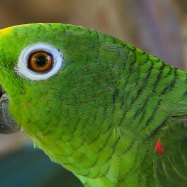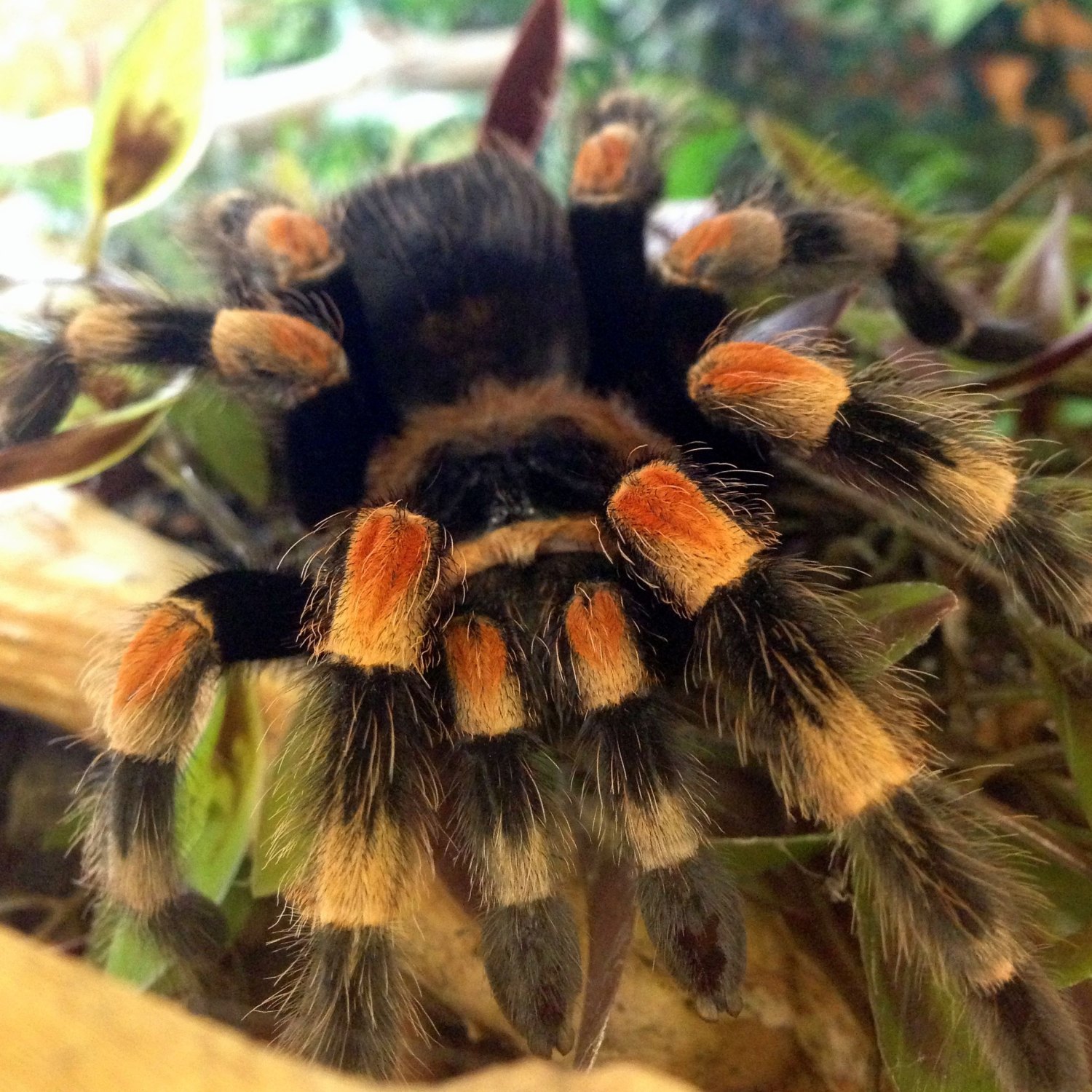
Red Knee Tarantula
5-6 inches (12-15 cm)
The Red Knee Tarantula is a medium-sized and stocky spider found in the Chihuahuan Desert. With a size of 5-6 inches (12-15 cm), this spider belongs to the Theraphosidae family and is a popular choice for exotic pet owners. Its distinctive red knee markings make it easily recognizable and it can live up to 30 years in captivity. However, be warned, they have a venomous bite, so it's best to admire them from a safe distance.
Animal Details Summary:
Common Name: Red Knee Tarantula
Kingdom: Animalia
Habitat: Terrestrial
The Fascinating Red Knee Tarantula: A Look into Its Life and Habits
Tarantulas, with their largest bodies of all spider species, have always been sources of fascination and fear for many. With their big, hairy bodies and eight legs, it is not surprising why these creatures have been depicted as terrifying monsters in movies and literature.Among the 850 species of tarantula, one stands out for its remarkable appearance and intriguing behavior – the Red Knee Tarantula. This article will delve into the life of this amazing arachnid, from its scientific classification to its physical features and habitat Red Knee Tarantula.
The Scientific Classification of Red Knee Tarantula
Before we dive into the world of Red Knee Tarantulas, let us first understand its scientific classification. The Red Knee Tarantula's scientific name is Brachypelma smithi. It belongs to the Animalia Kingdom, Arthropoda Phylum, and Arachnida Class. It also belongs to the order Araneae and the family Theraphosidae.The Appearance of Red Knee Tarantula
The Red Knee Tarantula, also known as Brachypelma smithi, is a medium-sized and stocky spider. On average, it measures around 5-6 inches or 12-15 cm in length. Its body has a black coloration with red-orange patches on its knees, giving it its name. It also has white stripes on its legs, making this spider a beautiful sight to behold.The Habitat and Feeding Habits of Red Knee Tarantula
The Red Knee Tarantula is a terrestrial spider, meaning it lives primarily on land Red Shouldered Hawk. It is native to the Chihuahuan Desert in Mexico, making this country its geographical distribution and country of origin. In its natural habitat, this species lives in burrows that it digs itself or takes over from other animals.Being carnivorous, the Red Knee Tarantula's diet mainly consists of insects, including crickets, locusts, and small rodents. Because of its size, it has impressive hunting skills, with venom that can paralyze its prey. Once caught, the Red Knee Tarantula will inject its prey with digestive enzymes to liquefy its insides, making it easier to suck out the nutrients.
The Behavior of Red Knee Tarantula
Despite their intimidating appearance, Red Knee Tarantulas are generally docile and non-aggressive creatures. They are known to be good pets among tarantula enthusiasts because of their calm temperament. When threatened, they will first raise their front legs as a warning sign. If the threat persists, they can use the barbed hairs on their abdomen to defend themselves.Another interesting behavior of the Red Knee Tarantula is their molting process. Like all spiders, they need to shed their exoskeleton to grow. During this process, they seclude themselves in their burrows and stop eating days before molting. After shedding, they will emerge with new, vibrant colors and a softer body, which will harden in a few hours.
The Importance of Red Knee Tarantula in the Ecosystem
Many people view tarantulas as pests or dangerous creatures to be feared and eliminated. However, tarantulas like the Red Knee Tarantula play a vital role in the ecosystem. As predators, they help keep the population of insects and other small animals in check.Additionally, they are also key players in the food chain, providing food for other animals like birds and mammals. Their burrowing activities also help aerate the soil, which is essential for plant growth.
Threats to Red Knee Tarantula
Although tarantulas are not endangered species, the Red Knee Tarantula faces threats in its natural habitat. One of the primary threats is habitat destruction due to urbanization and agricultural practices, leading to the loss of its burrowing sites.Furthermore, there is also a growing demand for Red Knee Tarantulas in the pet trade, resulting in poaching and illegal collection. It is crucial to regulate the pet trade to ensure the survival of the species in the wild.
Myths and Misconceptions About Red Knee Tarantula
As with many creatures, the Red Knee Tarantula has also been surrounded by myths and misconceptions. One of the most common is that all tarantulas are venomous and dangerous to humans. While tarantulas do have venom, their bites are not fatal and usually only cause pain and swelling. The venom is more of a defense mechanism against their prey, rather than humans.Another common misconception is that tarantulas are aggressive and will attack humans. As mentioned earlier, the Red Knee Tarantula is a docile species and will only attack if they feel threatened or provoked. As long as one respects their space, they will not harm anyone.
Tips for Keeping Red Knee Tarantula as Pets
If you are interested in keeping a Red Knee Tarantula as a pet, here are some tips to ensure you provide it with proper care:- Make sure to research and understand how to care for tarantulas before getting one as a pet.
- Provide a suitable habitat, preferably a glass tank with a secure lid.
- Keep the tank clean and maintain proper temperature and humidity levels.
- Feed it a variety of insects and make sure to remove any uneaten food to avoid bacterial growth.
- Handle with care and only when necessary, as excessive handling can stress the spider.
In Conclusion
The Red Knee Tarantula may seem like a terrifying creature, but it is truly a fascinating and essential part of our ecosystem. With their vibrant colors, calm demeanor, and unique behaviors, they prove to be more than just a subject of fear and disgust. It is crucial to educate ourselves and others about these creatures to dispel any myths and promote their preservation in the wild.

Red Knee Tarantula
Animal Details Red Knee Tarantula - Scientific Name: Brachypelma smithi
- Category: Animals R
- Scientific Name: Brachypelma smithi
- Common Name: Red Knee Tarantula
- Kingdom: Animalia
- Phylum: Arthropoda
- Class: Arachnida
- Order: Araneae
- Family: Theraphosidae
- Habitat: Terrestrial
- Feeding Method: Carnivorous
- Geographical Distribution: Mexico
- Country of Origin: Mexico
- Location: Chihuahuan Desert
- Animal Coloration: Black, red-orange, and white
- Body Shape: Medium-sized and stocky
- Length: 5-6 inches (12-15 cm)
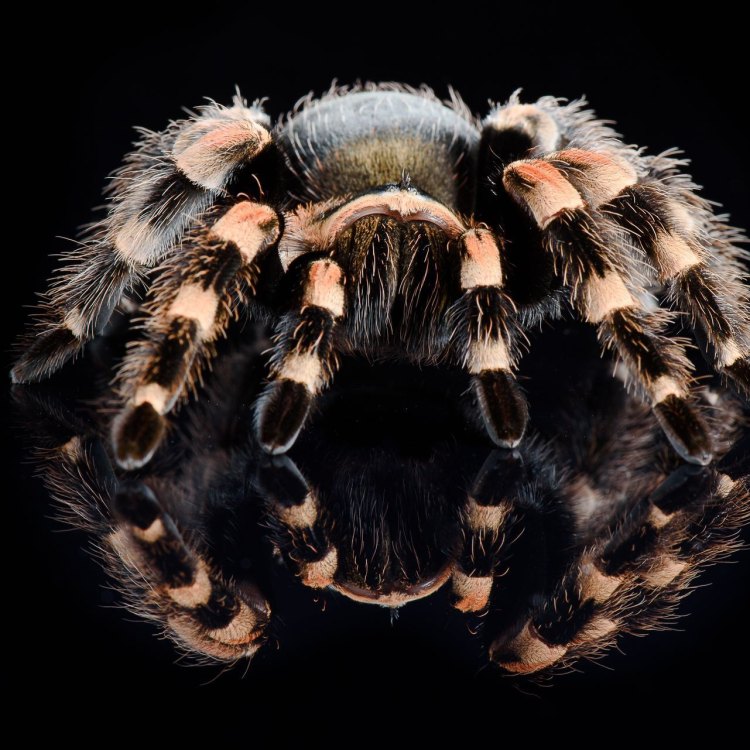
Red Knee Tarantula
- Adult Size: Females: 5-6 inches (12-15 cm), Males: 4-5 inches (10-13 cm)
- Average Lifespan: Up to 20 years
- Reproduction: Sexual
- Reproductive Behavior: Prominent courtship rituals
- Sound or Call: No sounds or calls
- Migration Pattern: Non-migratory
- Social Groups: Solitary
- Behavior: Nocturnal and terrestrial
- Threats: Habitat destruction and illegal pet trade
- Conservation Status: Vulnerable
- Impact on Ecosystem: Not a significant impact on ecosystems
- Human Use: Popular in the pet trade
- Distinctive Features: Bright red-orange knees and black body
- Interesting Facts: 1. The Red Knee Tarantula gets its name from the striking red-orange coloration on its knees. 2. They are known for their docile and calm behavior, making them popular as pets. 3. Red Knee Tarantulas are primarily carnivorous, feeding on insects, small vertebrates, and even other tarantulas. 4. Females have a longer lifespan than males, with some females living up to 20 years. 5. These tarantulas are found in dry areas of Mexico, particularly in the Chihuahuan Desert.
- Predator: Predators include larger spiders, birds, reptiles, and mammals.
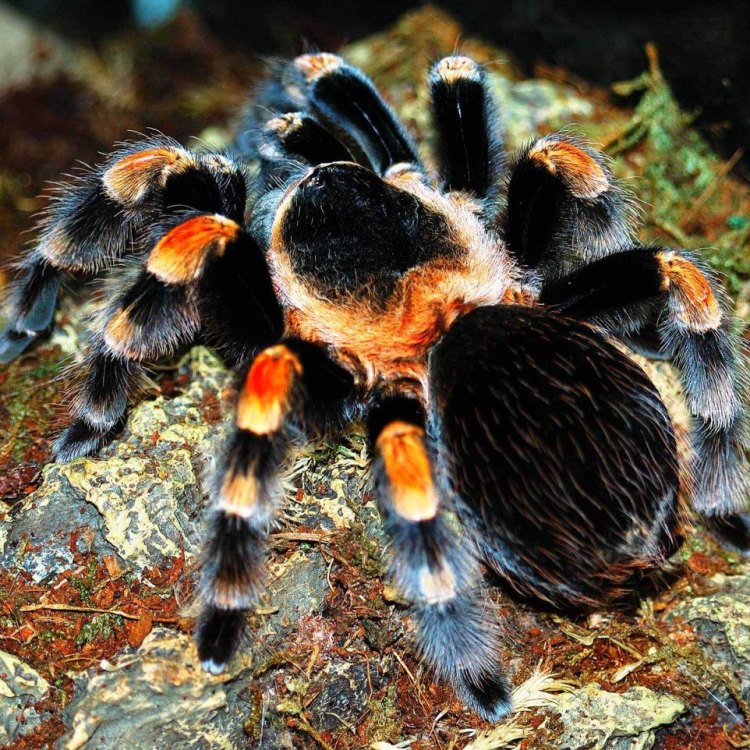
Brachypelma smithi
The Red Knee Tarantula: A Fascinating Creature of the Mexican Desert
Deep in the dry, rocky regions of Mexico, there is a fascinating creature that has captured the attention of many: the Red Knee Tarantula. With its distinctive bright red-orange knees and calm demeanor, this arachnid has become a popular pet in the exotic animal trade. But there is more to this creature than meets the eye. In this article, we will delve into the unique features and behavior of the Red Knee Tarantula, its role in the ecosystem, and the threats it faces in the wild PeaceOfAnimals.Com.Understanding the Red Knee Tarantula
The Red Knee Tarantula, also known as the Mexican Red Knee Tarantula, is a species of tarantula native to the dry regions of Mexico. It belongs to the genus Brachypelma, which includes over 26 species of tarantulas found in Central and South America. This particular species is highly sought after in the pet trade for its striking appearance and docile nature.Distinctive Features
One glance at the Red Knee Tarantula and it's easy to see how it got its name. The bright red-orange coloration on its knees is its most distinctive feature, contrasting sharply with its predominantly black body. This coloration is more prominent in females, while males tend to have duller colors. Another interesting feature of this tarantula is its relatively large size. Females can grow up to 5-6 inches (12-15 cm), while males are slightly smaller at 4-5 inches (10-13 cm).Behavior and Reproduction
Red Knee Tarantulas are primarily solitary creatures, with minimal social interactions Redhump Eartheater. They are nocturnal and spend most of their time on the ground, hiding under rocks, logs, or in burrows. These tarantulas are also known for their docile and calm temperament. They seldom show aggression unless provoked, making them suitable as pets for experienced tarantula keepers.When it comes to reproduction, Red Knee Tarantulas follow the traditional sexual reproduction method. Males use prominent courtship rituals to attract females, and once the female accepts a male, they mate. Females can lay up to 400 eggs at once, which they protect in a silken egg sac until they hatch. Interestingly, female Red Knee Tarantulas have a longer lifespan than males, with some living up to 20 years.
Feeding Habits
Like most tarantulas, the Red Knee Tarantula is primarily carnivorous and feeds on a variety of prey. In the wild, they prey on insects, small vertebrates, and even other tarantulas. As pets, they can be fed with live insects such as crickets or mealworms, appropriately sized for their body size.Habitat and Distribution
The Red Knee Tarantula is endemic to the Chihuahuan Desert region of Mexico, which covers parts of Arizona, Texas, and New Mexico. They prefer to live in dry areas, such as grasslands, scrublands, and deserts. These areas offer ample hiding spots, where these tarantulas can escape the heat or predators.Predators and Role in the Ecosystem
While the Red Knee Tarantula is not at the top of the food chain, it has a vital role to play in its ecosystem. As predators, they help control the population of insects and other small creatures. They are also prey to larger spiders, birds, reptiles, and mammals, such as coyotes and foxes. Their venom is not lethal to humans, but it can be harmful to smaller animals.Threats and Conservation Status
The Red Knee Tarantula is considered vulnerable by the International Union for Conservation of Nature (IUCN). The main threat to their population is habitat destruction due to urbanization, agriculture, and mining activities. Another significant threat is the illegal pet trade, where these tarantulas are captured from the wild and sold in markets around the world. This practice has greatly reduced their numbers in the wild, and strict measures need to be taken to regulate the trade and preserve their population.Human Use and Interesting Facts
While Red Knee Tarantulas are not domesticated animals, they are widely kept as pets by many tarantula enthusiasts. Their popularity in the pet trade has led to concerns about the sustainability of their wild population. Despite this, many breeders have successfully bred these tarantulas in captivity, and it is always recommended to purchase captive-bred animals to reduce the demand for wild-caught specimens.Here are some interesting facts about the Red Knee Tarantula:
- The hair on their body is highly sensitive to vibrations, making them efficient hunters.
- They are entirely diurnal, which means they are most active at dawn and dusk.
- Red Knee Tarantulas are not known to make any sounds or calls.
- They are known to be quite docile and have been observed interacting with their keepers, showing signs of recognition and social behavior.
- Red Knee Tarantulas have eight eyes, which they use to detect movement and light.
In Conclusion
The Red Knee Tarantula is a fascinating creature with its striking appearance, docile behavior, and vital role in its ecosystem. While it may seem intimidating, these tarantulas make excellent pets for experienced owners. However, we must also remember to prioritize their conservation and discourage the illegal trade to ensure their survival in the wild. With proper regulation and responsible ownership, we can continue to admire these unique creatures in their natural habitat for years to come.
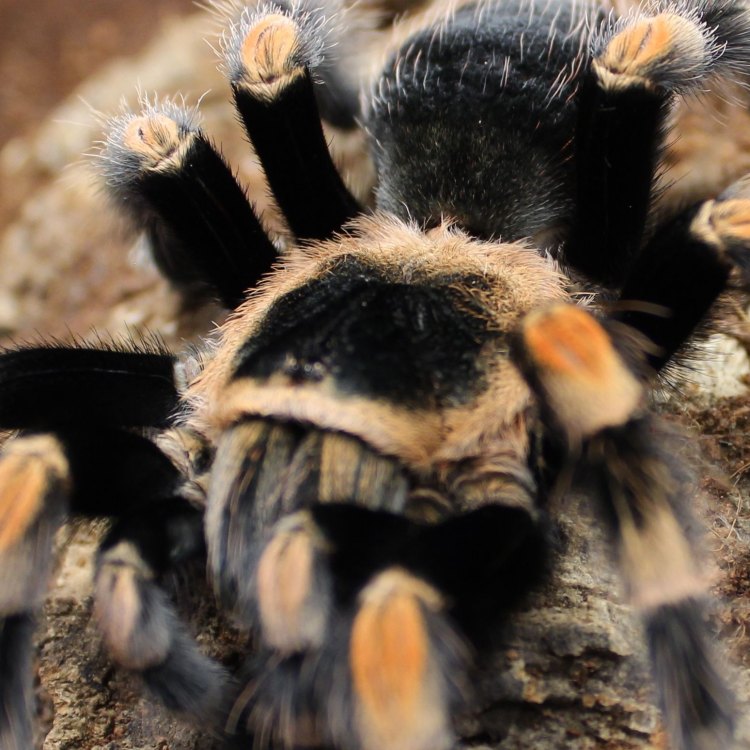
The Fascinating Red Knee Tarantula: A Look into Its Life and Habits
Disclaimer: The content provided is for informational purposes only. We cannot guarantee the accuracy of the information on this page 100%. All information provided here may change without prior notice.







